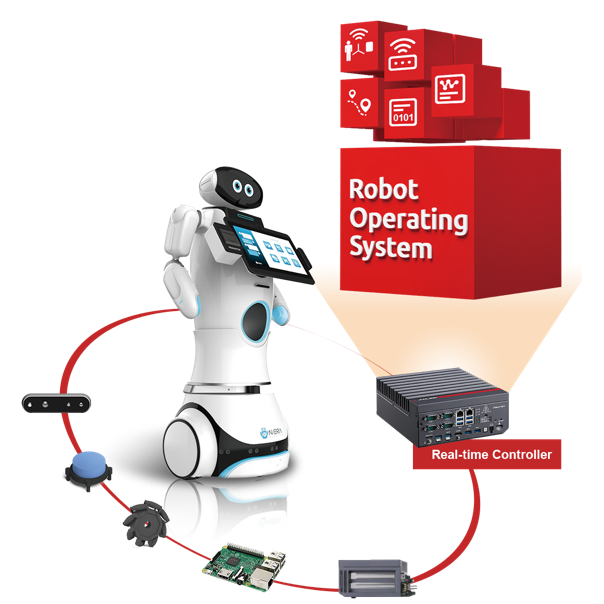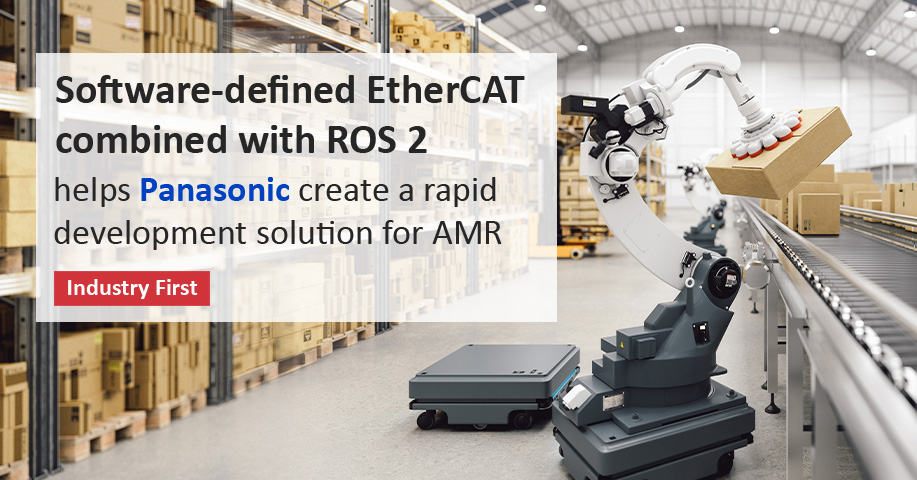
Hospital Challenges
Healthcare systems are an invaluable asset in the modern world; however, little technological effort has been made to address the shortage of medical workers, and to relieve their physical and mental stress. Since 2020, the COVID-19 pandemic has overwhelmed hospitals to the point of collapse, but has also accelerated the development and deployment of Autonomous Mobile Robots (AMR) to serve a wide range of medical purposes.
In 2021, Taichung Veterans General Hospital, in collaboration with N.ERA and ADLINK, the edge computing leader, successfully deployed AMRs for contactless delivery of heavy surgical instruments and equipment, reducing the physical workload of the medical staff, as well as saving up to 5,000 man-hours per annum.

Ligo Lim, New Era AI Robotic’s Head of Global Sales and Marketing., highlighted two fundamental principles in terms of AMR applications. Firstly, we need to think strategically about what problems they can solve. Secondly, our guiding principle must be customer-oriented design – the AMRs must be designed in context of the existing operating procedures and the operational environment in which they’ll be operating.
Taichung Veterans General Hospital first introduced AMRs in order to reduce labor costs for time-intensive tasks. After conducting some analysis, the hospital determined that deliveries of heavy surgical instrument and equipment was the most physically and time-intensive task. N.ERA set out to alleviate this problem and provide a customized solution that would automate repeated tasks and unlock more valuable time for medical personnel to focus on other important tasks and responsibilities. In doing so, N.ERA truly demonstrated the value and power of Human-Robot Collaboration (HRC).
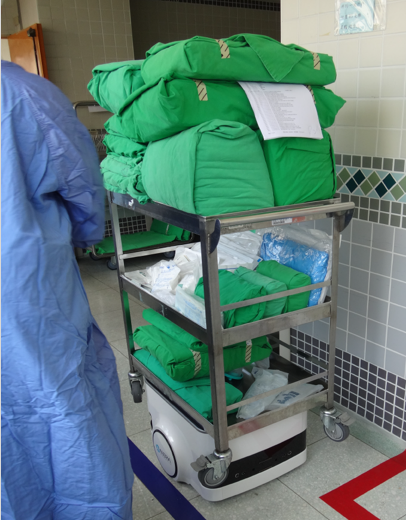
Customized Medical AMR
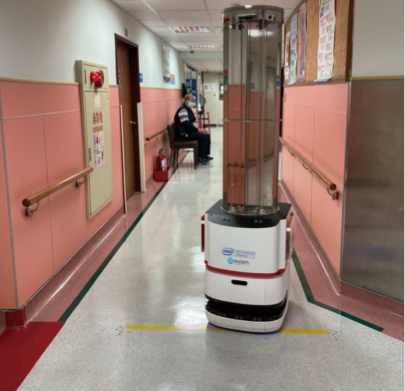
Once the goal was clear, the next step was to undergo customer-oriented customization.
Firstly, N.ERA digitalized the hospital’s operating procedures, then developed a compatible software application for the AMRs. With one simple click, the AMRs would proceed to the operating room, complete its delivery, then automatically return to the instrument room. Operating the AMRs was easy and 100% compatible with the hospital operating procedures.
Secondly, adjustments had to be made to the AMRs in order to function properly and safely in the hospital environment. The actual width of the corridors in Taichung Veterans General Hospital is only 80 cm, which is quite narrow. In high-traffic corridors, collisions will be inevitable. With that potential problem in mind, hazard identification or risk assessment methods had to be addressed early in the design process in order to decrease the chance of collisions. N.ERA tweaked their algorithms, enabling the AMRs to nimbly and flexibly adapt to new environments. With new elements such as light detection and ranging (lidar), 3D camera and ultrasound, the AMRs’ obstacle avoidance capabilities have been optimized to their full potential.
ADLINK’s dedicated ROS team and software and hardware integration capabilities truly makes for a fantastic partner in any robotics solution development project.
N.ERA has been highly active in robotics development for the past 7 years. During this period, N.ERA has been in contact with several controller suppliers, ADLINK being the sole firm capable of software integration and shortening N.ERA’s product development cycle. Dr. Bill Wang of ADLINK’s New Generation Robotics Platform Division added, “ADLINK started as an industrial PC manufacturer, and these years we proceeded to expand our business in the field of robotics, integrating industrial fanless PCs with ROS as well as providing mobile robot platform hardware and software integration solutions that directly address mission-critical businesses.”
ADLINK has a well-trained team dedicated to ROS. With ADLINK’s reliable support and ROS technical expertise, N.ERA can place complete trust in ADLINK’s hardware and software integration solutions for robot controllers. Through this complementary partnership with ADLINK, N.ERA is able to concentrate on mission-critical applications and development, paving the way for the improved and optimized customizations and UI and UX designs, and in turn, significantly boosting the development of N.ERA’s product portfolio.

“In helping Taichung Veterans General Hospital set up AMRs, we were aware that actually, there was still a demand for a higher degree of customization. And thanks to ADLINK, our product developers could devote all their energies to the part of customization without worrying about ROS 2 integration issues, hence the invention of the robot that truly fulfils the needs of the hospital,” said Ligo Lim.
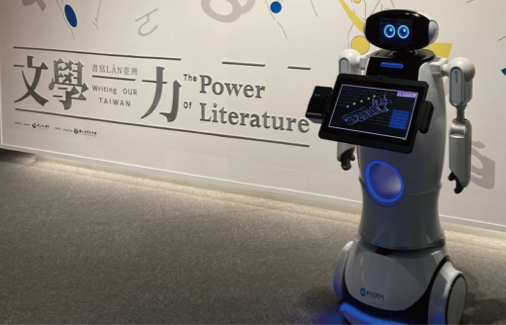

“In helping Taichung Veterans General Hospital set up AMRs, we were aware that actually, there was still a demand for a higher degree of customization. And thanks to ADLINK, our product developers could devote all their energies to the part of customization without worrying about ROS 2 integration issues, hence the invention of the robot that truly fulfils the needs of the hospital,” said Ligo Lim.
Adopting ADLINK’s ROS 2 and Intel’s computing technologies to build a AMR partner ecosystem
While the AMRs are in operation, their sensors have to constantly monitor the ever changing environmental conditions and rapidly adjust their route. This level of real-time course correcting creates an enormous computing workload for the hardware. This model of N.ERA’s AMRs utilized a miniaturized controller. Developed jointly by ADLINK and Intel, this technology is a ROS 2-enabled robotic controller based on Intel’s 11th Gen Tiger Lake CPU, whose processing speed and system execution speed are 20% faster and whose power dissipation is way lower than those of the previous generation. These improvements shed light on the AMRs’ impressive obstacle avoidance and greater endurance. Even better, their connectors also meet N.ERA’s requirements.
ROS 2 is already underway, and N.ERA will almost certainly implement this technology. In anticipation of N.ERA development roadmap, ADLINK has made some adjustments to the design that could help simplify and streamline development processes based on ROS 2. After that, ADLINK introduced the integrated software package, Neuron SDK, to their users. Neuron SDK is highly beneficial to the new AMRs because it is a comprehensive and user-friendly solution that guides users through the prototyping and ROS 2 robot application testing processes with ease.
Ligo Lim relished the prospect of continuing the collaboration with ADLINK. With ADLINK’s long-term and close partnership with Intel, N.ERA will be able to develop smarter, more efficient AI-based robots leveraging Intel’s resources. Bill Wang further affirmed this partnership - ADLINK hopes to join hands with more system integration providers and robotic components manufacturers to expand its robotics ecosystem, to promote the application of AMRs in various industries and to help more people see the core value of AMR technology.
